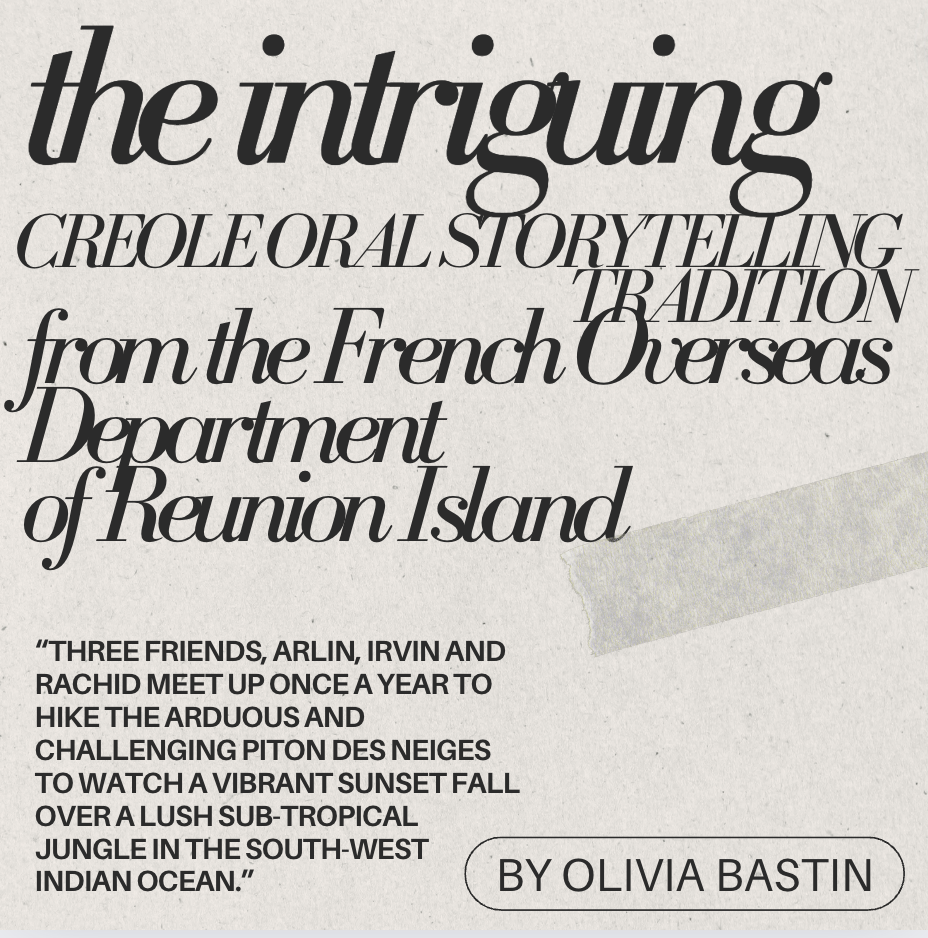The Intriguing Creole Oral Storytelling Tradition from the French Overseas Department of Reunion Island
By Olivia Bastin
Three friends, Arlin, Irvin and Rachid meet up once a year to hike the arduous and challenging Piton des Neiges to watch a vibrant sunset fall over a lush sub-tropical jungle in the South-West Indian Ocean. One is Muslim, one is Christian, and the other is Hindu. Their reunion was legendary. Hence, the very island they lived on reverted from being named Bourbon to La Réunion. This far flung overseas French department lies west of Madagascar and east of Mauritius and is brimming with the fascinating creole tradition of oral storytelling told by “raconkër zistwar”. These tales pay homage to a unique religious and cultural melting pot of peoples with geographical routes spanning back to Africa, Southeast Asia, and Europe. Within the very architectural fabric of the island, one can find a Tamil temple built across the road from a Chinese pagoda or mosque or Roman-Catholic church. It is no surprise that the ethno-histories and superstitions of the Malbars, (Tamil of South-East India) the Sinoi, (Chinese) Z’arabes, (Arabs) the Cafres, (Sub-Saharan and Malagasy peoples) and the Zorieles (Metropolitan France) are orally performed for entertainment and twisted into tales of adventure, riches or terror. Or sung through colourfully choreographed performances within Séga and maloya music which can equally be enjoyed on the two other Mascarene islands.
Yet there is one folkloric tale which each ethnic group on the island is familiar with. This myth is of the terrifying witch named “grand-mère Kalle” (granmèr Kal in Creole) who haunts the wild southern lands of the volcano named ‘le Piton de la Fournaise’. This active volcano viciously spews red hot magma into the endless depths of the ocean. Grand-mère Kalle resides in the “sud-savage,” in the physical form of a big black bird with her husband the Devil in a deserted Martian landscape. If one hears her cries of “tout, toout” then they can expect immediate danger or misfortune. Yet grand-mère Kalle was not always a witch; she was once a cruel and sadistic slave owner. Consequently, her slaves poisoned her and fled into the Cirque de Mafate where they lived peacefully for the rest of their days. Yet this version of the myth has transcended into a popular game for children all over the island. A child drapes a shawl over their head and aims to physically catch the other children. Of course, it makes the British version of “hide and seek” seem tame in comparison. Grand-mère Kalle is notorious for her hatred of mischievous children and is rumoured to kidnap them at night. No wonder this version of “hide and seek” is a fraught affair if she is similar to the British “Bogeyman”. It seems as if grand-mère Kalle’s wicked ways do not cease. Another myth tells of her hiding convicts in her house, encouraging them to commit crimes. Therefore, if a traveller passes by, grand-mère Kalle will appear and invite them round for a drink. If the travellers' pockets are laden with coins, the convicts will rob them and dispose of their body in a local ravine. When Kalle passed away, she was rumoured to haunt the houses of the sick. If one heard her laugh, one would shortly die, yet if one heard her cry, they may make a speedy recovery.
This part of the island’s intangible heritage has even been used in a limited-edition marketing campaign called “Gran Merkal” for Réunion’s iconic le dodo bière produced throughout the 24 communes by the Bourbon brewing company. This brewing company uses the famous Mauritian dodo bird (hunted to extinction by humans) as its upbeat, brightly coloured yellow and red logo. The creole slogan reads “le dodo lé la” which translates to ‘the dodo is here’. But fear not, a skeleton of a dodo bird can be viewed on the second floor of the “jardin de l’état” in the administrative capital of Saint- Denis. Or alternatively, one can buy a fridge magnet of these avian creatures frolicking in the verdant paradisal forests of La Réunion where all manner of creatures such as sleeper chameleon (indigenous to the island) can be located. The marketing campaign cleverly pasted the image of the witch with a hooked nose and broomstick onto the bottle. Even the music scene of La réunion has plentiful references to this terrifying figure. For example, “la nuit de Kal” is an annual rock metal festival taking place on Halloween in the city of Saint-Paul – spooky! Additionally, a song about grand-mère Kalle was written by the musical group Ziskakan. She may be the stuff of nightmares, but you can’t deny she is a celebrity!
In conclusion, there is an abundance of myths and legends on this little island on the coast of Madagascar, yet it is fascinating how one myth can consume the collective memory and imagination of the island’s inhabitants so vividly. Whether that is through popular children’s games, Réunion’s musical scene, the wild volcanic southland or even through the visual merchandising of the island’s most popular beer, it seems grand-mère Kalle is an intangible cultural feature of La Réunion. Just make sure you never cross her path!
References
https://www.france-voyage.com/gastronomy/dodo-beer-653.htm


.png)
Comments
Post a Comment